JOINT BASE ELMENDORF-RICHARDSON, Alaska—The temperature hovered in the mid-teens, and the skies were crystal blue here March 14 as members of the Alaska Air National Guard’s 211th Rescue Squadron prepared for a seven-hour round-trip flight north, well into the Arctic Circle. The mission, part of the ongoing biannual Arctic Edge exercise, was to drop an Arctic Sustainment Package, consisting of Guardian Angel Airmen and a pallet of survival gear, onto an ice pack 200 miles off the northern coast of Alaska where they would set up camp.
Despite the near-perfect conditions on the ground, the weather can change in an instant in the Arctic, and crews know they must be prepared for anything.
“Weather is great here, but it doesn’t look great up north,” said Capt. Chris McKnight, the mission’s HC-130J pilot. “It’s [going to be] white on white. It’s like flying in a golf ball.”
The temperature also will plummet. Depending on the time of year, it could drop as low as minus 60 degrees in Alaska. When the rear ramp opens on this mission, McKnight will be flying 130 knots—about 150 miles per hour—and the temperature will be at least minus 20 degrees, likely colder. That kind of freezing wind is enough to shock anyone’s system, but Capt. Miles Brodsky, a combat rescue officer with the Alaska ANG’s 212th Rescue Squadron and the flight commander for the mission, said, “It’s one of the most amazing experiences ever.”
But training is key to survival.
“People talk about flow state, or like, hyper-focused,” Brodsky told Air Force Magazine during an interview on base before the flight. “It’s like everything we train for coming up to that one moment. It’s almost like everything goes in slow motion, and you can see every step forward, 10 steps at a time. It is the ultimate ‘being in the moment,’ I would say, because you’re just completely focused on executing this mission properly and getting out of the plane.”
The 212th has a unique mission. It is the only unit in the entire Department of Defense with an Arctic Sustainment Package capability—Canada is the only other country in the world with the capability, said Lt. Col. John Romspert, commander of the 212th RQS. Created in 2010 after the Northwest Passage and Polar Ice Cap started melting, making room for more Arctic exploration, tourism, and nation building, the baseline Arctic Sustainment Package is capable of treating 23 people in 96 hours in the harshest of conditions.
It includes one combat rescue officer, a survival, evasion, resistance, and escape (SERE) specialist, and four pararescue jumpers. They jump with up to five modular pallets of survival gear, including everything from vehicles to tents.
The SERE specialist will help set up the camp and keep an eye out for rapidly changing environmental conditions as the PJs treat any survivors on the ground and the combat rescue officer focuses on resupply and getting everyone safely home, Romspert said.
“What a lot of people who don’t operate in the Arctic realize is how dynamic it is,” he said. “It could be clear blue when you jump in, and 45 minutes later, you’re in a storm that lasts for 10 days at minus 60 degrees. So, just because you got in, doesn’t mean you’re going to get out right away. It takes a team effort and constant coordination to make sure that the operation is just running smoothly.”
In the Arctic, the weather is the biggest adversary, and Airmen operating in these conditions need to understand how to control their own body temperature. Too many layers, and you might start sweating, and that could freeze later and lead to hypothermia. Not enough layers, and again, hypothermia could set in.
“We are constantly managing our own bodies in the situation, our own layers, just to exist in the environment,” Brodsky said. “We always have to be thinking ahead because if we’re staying in the evening, or a couple of nights, the environment becomes a huge factor … It’s just a constant challenge … that’s why we train a lot.”
Arctic Edge, which runs through March 17, is a U.S Northern Command-scheduled exercise with some 1,000 U.S. and Canadian forces participating. First held in 2018, it takes place every two years, with the goal of providing realistic training throughout Alaska. It is the largest joint exercise in Alaska this year and one of several occurring simultaneously, including the National Guard’s Arctic Eagle/Patriot, the U.S. Army’s Joint Pacific Multinational Readiness Capability exercise, and the U.S. Navy’s ICE-X.
“Arctic operations and exercises such as Arctic Edge demonstrate the capabilities utilized to defend our homeland and our interests,” said Lt. Gen. David A. Krumm, commander of Alaskan North American Aerospace Defense Command, Alaskan Command, and 11th Air Force. “To deter day-to-day, de-escalate in crisis, and if required, defeat in conflict, we must be able to operate and thrive in the Arctic.”
